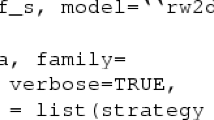Abstract
The main purpose of this paper is to propose a Bayesian nonparametric estimation of density’s level sets from n independent identically distributed observations. We prove the strong consistency of posterior distribution under a fairly general class of priors. This entails, in particular, that the Bayes estimate of the level set is consistent in terms of the Lebesgue measure of the symmetric difference. The considered priors put mass on piecewise-constant densities. The pieces on which the densities are constant are Voronoi tiles generated by a spatial point process. Using conditions similar to those considered in the density framework, we also obtain the consistency of the Bayesian level set estimates in the regression model. We present a simulation study using a special prior in the framework of density level set estimation. This allows us to visualise the numerical performances of the Bayesian estimate and to compare them to a plug-in level set estimate.
Similar content being viewed by others
References
Arjas E, Gasbarra D (1994) Nonparametric Bayesian inference from right censored survival data, using the Gibbs sampler. Stat Sin 4:505–524
Arjas E, Heikkinen J (1997) An algorithm for nonparametric Bayesian estimation of a Poisson intensity. Comput Stat 12:385–402
Arjas E, Heikkinen J (1998) Non-parametric Bayesian estimation of a spatial Poisson intensity. Scand J Stat 25:435–450
Arjas E, Heikkinen J (1999) Modeling a Poisson forest in variable elevations: a nonparametric Bayesian approach. Biometrics 55:738–745
Baillo A, Cuesta-Albertos JA, Cuevas A (2001) Convergence rates in nonparametric estimation of level sets. Stat Probab Lett 53:27–35
Barron A, Schervish MJ, Wasserman L (1999) The consistency of posterior distribution in nonparametric problems. Ann Stat 27:536–561
Byers SD, Raftery AE (2002) Bayesian estimation and segmentation of spatial point processes using Voronoi tilings. In: Lawson, AG, Denison, DGT (eds) Spatial cluster modelling. Chapman & Hall/CRC Press, London
Cuevas A, Febrero M, Fraiman R (2000) Estimating the number of clusters. Can J Stat 28:367–382
Denison DGT, Mallick BK, Smith AFM (1998) Non-parametric Bayesian estimation of a spatial Poisson intensity. Automatic Bayesian curve fitting. J Roy Stat Soc Ser B 60:333–350
Diaconis P, Freedman D (1986) On the consistency of Bayes estimates. Ann Stat 14:1–26
Gayraud G, Rousseau, J (2002) Nonparametric Bayesian estimation of level sets. Technical report 2002-03, CREST, www.crest.fr/doctravail/liste.htm
Gayraud G, Rousseau J (2005) Rates of convergence for a Bayesian level set estimation. Scand J Stat 32:639–660
Green PJ (1995) Reversible jump Markov chain Monte Carlo computation and Bayesian model determination. Biometrika 82:711–732
Hartigan J (1987) Estimation of a convex density contour in two dimensions. J Am Stat Assoc 82:267–270
Hartigan JA (1975) Clustering algorithms. Wiley, New York
Heikkinen J (1998) Curve and surface estimation using dynamic step functions. In: Dey PMD, Sinha D (eds) Practical nonparametric and semiparametric Bayesian statistics. Springer, New York, pp 255–272
Müller DW, Sawitzki G (1991a) Excess mass estimates and tests for multimodality. J Am Stat Assoc 86:738–746
Müller DW, Sawitzki G (1991b) Using excess mass estimates to investigate the modality of a distribution. In: The frontiers of statistical scientific theory & industrial applications. American series in mathematical and management sciences, vol 26. American Sciences Press, New York, pp 355–382
Nicholls G (1998) Bayesian image analysis with Markov chain Monte Carlo and colored continuum triangulation models. J Roy Stat Soc Ser B 60:643–659
Nolan D (1991) The excess mass ellipsoid. J Multivar Anal 39:348–371
Polonik W (1995) Measuring mass concentration and estimating density contours clusters-an excess mass approach. Ann Stat 23:855–881
Simar L (1992) Estimating efficiencies from frontier models with panel data: a comparison of parametric, non-parametric and semi-parametric methods with bootstrapping. J Prod Anal 3:167–203
Tsybakov A (1997) On nonparametric estimation of density level sets. Ann Stat 25:948–969
Walther G (1997) Granulometric smoothing. Ann Stat 25:2273–2299
Author information
Authors and Affiliations
Corresponding author
Rights and permissions
About this article
Cite this article
Gayraud, G., Rousseau, J. Consistency results on nonparametric Bayesian estimation of level sets using spatial priors. TEST 16, 90–108 (2007). https://doi.org/10.1007/s11749-006-0003-0
Received:
Accepted:
Published:
Issue Date:
DOI: https://doi.org/10.1007/s11749-006-0003-0
Keywords
- Bayesian nonparametric estimation
- Consistency
- Level Sets
- Reversible jump MCMC
- Spatial point process
- Voronoi tessellation




